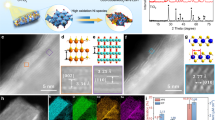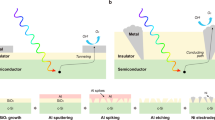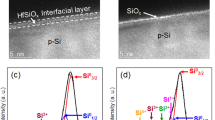Abstract
The photoelectrochemical splitting of water into hydrogen and oxygen requires a semiconductor to absorb light and generate electron–hole pairs, and a catalyst to enhance the kinetics of electron transfer between the semiconductor and solution. A crucial question is how this catalyst affects the band bending in the semiconductor, and, therefore, the photovoltage of the cell. We introduce a simple and inexpensive electrodeposition method to produce an efficient n-Si/SiOx/Co/CoOOH photoanode for the photoelectrochemical oxidation of water to oxygen. The photoanode functions as a solid-state, metal–insulator–semiconductor photovoltaic cell with spatially non-uniform barrier heights in series with a low overpotential water-splitting electrochemical cell. The barrier height is a function of the Co coverage; it increases from 0.74 eV for a thick, continuous film to 0.91 eV for a thin, inhomogeneous film that has not reached coalescence. The larger barrier height leads to a 360 mV photovoltage enhancement relative to a solid-state Schottky barrier.
This is a preview of subscription content, access via your institution
Access options
Subscribe to this journal
Receive 12 print issues and online access
$259.00 per year
only $21.58 per issue
Buy this article
- Purchase on Springer Link
- Instant access to full article PDF
Prices may be subject to local taxes which are calculated during checkout




Similar content being viewed by others
References
Lewis, N. S. & Nocera, D. G. Powering the planet: Chemical challenges in solar energy utilization. Proc. Natl Acad. Sci. USA 103, 15729–15735 (2006).
Walter, M. G. et al. Solar water splitting cells. Chem. Rev. 110, 6446–6473 (2010).
Lin, F. & Boettcher, S. W. Adaptive semiconductor/electrocatalyst junctions in water-splitting photoanodes. Nature Mater. 13, 81–86 (2014).
Gamelin, D. R. Water splitting: Catalyst or spectator? Nature Chem. 4, 965–967 (2012).
Guo, L. et al. Tunnel barrier photoelectrodes for solar water splitting. Appl. Phys. Lett. 97, 063111 (2010).
Esposito, D. V., Levin, I., Moffat, T. P. & Talin, A. A. H2 evolution at Si-based metal–insulator–semiconductor photoelectrodes enhanced by inversion channel charge collection and H spillover. Nature Mater. 12, 562–568 (2013).
Switzer, J. A. The n-silicon/thallium(III) oxide heterojunction photoelectrochemical solar cell. J. Electrochem. Soc. 133, 722–728 (1986).
Chen, Y. W. et al. Atomic layer-deposited tunnel oxide stabilizes silicon photoanodes for water oxidation. Nature Mater. 10, 539–544 (2011).
Fan, F.-R. F., Keil, R. G. & Bard, A. J. Semiconductor electrodes. 48. Photooxidation of halides and water on n-silicon protected with silicide layers. J. Am. Chem. Soc. 105, 220–224 (1983).
Kenney, M. J. et al. High-performance silicon photoanodes passivated with ultrathin nickel films for water oxidation. Science 342, 836–840 (2013).
Lauwers, A. et al. Electrical transport in (100)CoSi2/Si contacts. J. Appl. Phys. 77, 2525–2536 (1995).
Reece, S. Y. et al. Wireless solar water splitting using silicon-based semiconductors and earth-abundant catalysts. Science 334, 645–648 (2011).
Subbaraman, R. et al. Trends in activity for the water electrolyser reactions on 3d M(Ni, Co, Fe, Mn) hydr(oxy)oxide catalysts. Nature Mater. 11, 550–557 (2012).
Koza, J. A., Hull, C. M., Liu, Y.-C. & Switzer, J. A. Deposition of β-Co(OH)2 films by electrochemical reduction of tris(ethylenediamine)cobalt(III) in alkaline solution. Chem. Mater. 25, 1922–1926 (2013).
Marsh, D. A. et al. Water oxidation using a cobalt monolayer prepared by underpotential deposition. Langmuir 29, 14728–14732 (2013).
Young, E. R., Costi, R., Paydavosi, S., Nocera, D. G. & Bulović, V. Photo-assisted water oxidation with cobalt-based catalyst formed from thin-film cobalt metal on silicon photoanodes. Energy Environ. Sci. 4, 2058–2061 (2011).
Yang, J. et al. Efficient and sustained photoelectrochemical water oxidation by cobalt oxide/silicon photoanodes with nanotextured interfaces. J. Am Chem. Soc. 136, 6191–6194 (2014).
Hu, S. et al. Amorphous TiO2 coatings stabilize Si, GaAs, and GaP photoanodes for efficient water oxidation. Science 344, 1005–1009 (2014).
Munford, M. L., Sartorelli, M. L., Seligman, L. & Pasa, A. A. Morphology and magnetic properties of Co thin films electrodeposited on Si. J. Electrochem. Soc. 149, C274–C279 (2002).
Gerken, J. B. et al. Electrochemical water oxidation with cobalt-based electrocatalysts from pH 0–14. The thermodynamic basis for catalyst structure, stability, and activity. J. Am. Chem. Soc. 133, 14431–14442 (2011).
Sze, S. Physics of Semiconductor Devices 2nd edn (Wiley-Interscience, 1981).
Card, H. C. & Rhoderick, E. H. Studies of tunnel MOS diodes I. Interface effects in silicon Schottky diodes. J. Phys. D: Appl. Phys. 4, 1589–1601 (1971).
Ng, K. K. & Card, H. C. A comparison of majority- and minority-carrier silicon MIS solar cells. IEEE Trans. Electron. Dev. 27, 716–724 (1980).
Cowley, A. M. & Sze, S. M. Surface states and barrier height of metal–semiconductor systems. J. Appl. Phys. 36, 3212–3220 (1965).
Tung, R. T. Electron transport at metal–semiconductor interfaces: General theory. Phys. Rev. B 45, 13509–13523 (1992).
Nakato, Y., Ueda, K., Yano, H. & Tsubomura, H. Effect of microscopic discontinuity of metal overlayers on the photovoltages in metal-coated semiconductor-liquid junction photoelectrochemical cells for efficient solar energy conversion. J. Phys. Chem. 92, 2316–2324 (1988).
Rossi, R. C. & Lewis, N. S. Investigation of the size-scaling behavior of spatially nonuniform barrier height contacts to semiconductor surfaces using ordered nanometer-scale nickel arrays on silicon electrodes. J. Phys. Chem. B 105, 12303–12318 (2001).
Reineke, R. & Memming, R. High barrier GaAs/metal Schottky junctions produced by electrochemical metal deposition. Surf. Sci. 192, 66–80 (1987).
Vereecken, P. M., Vanalme, G. M., Van Meirhaeghe, R. L., Cardon, F. & Gomes, W. P. Electrochemical reduction vs. vapour deposition for n-GaAs/Cu Schottky-barrier formation: A comparative study. J. Chem. Soc. Faraday Trans. 92, 4069–4075 (1996).
Lewerenz, H. J. Operational principles of electrochemical nanoemitter solar cells for photovoltaic and photoelectrocatalytic applications. J. Electroanal. Chem. 662, 184–195 (2011).
Acknowledgements
This material is based on work supported by the US Department of Energy, Office of Basic Energy Sciences, Division of Materials Sciences and Engineering, under Grant No. DE-FG02-08ER46518.
Author information
Authors and Affiliations
Contributions
J.C.H. and A.T.L. prepared the samples and performed all measurements. J.C.H. and J.A.S. wrote the manuscript. J.A.S. directed the research.
Corresponding author
Ethics declarations
Competing interests
The authors declare no competing financial interests.
Supplementary information
Supplementary Information
Supplementary Information (PDF 1296 kb)
Rights and permissions
About this article
Cite this article
Hill, J., Landers, A. & Switzer, J. An electrodeposited inhomogeneous metal–insulator–semiconductor junction for efficient photoelectrochemical water oxidation. Nature Mater 14, 1150–1155 (2015). https://doi.org/10.1038/nmat4408
Received:
Accepted:
Published:
Issue Date:
DOI: https://doi.org/10.1038/nmat4408
This article is cited by
-
Scalable, highly stable Si-based metal-insulator-semiconductor photoanodes for water oxidation fabricated using thin-film reactions and electrodeposition
Nature Communications (2021)
-
Manipulating metal-oxygen local atomic structures in single-junctional p-Si/WO3 photocathodes for efficient solar hydrogen generation
Nano Research (2021)
-
Nanoscale semiconductor/catalyst interfaces in photoelectrochemistry
Nature Materials (2020)
-
Anti-photocorrosive photoanode with RGO/PdS as hole extraction layer
Science China Materials (2020)
-
Tailoring the photoelectrochemistry of catalytic metal-insulator-semiconductor (MIS) photoanodes by a dissolution method
Nature Communications (2019)



